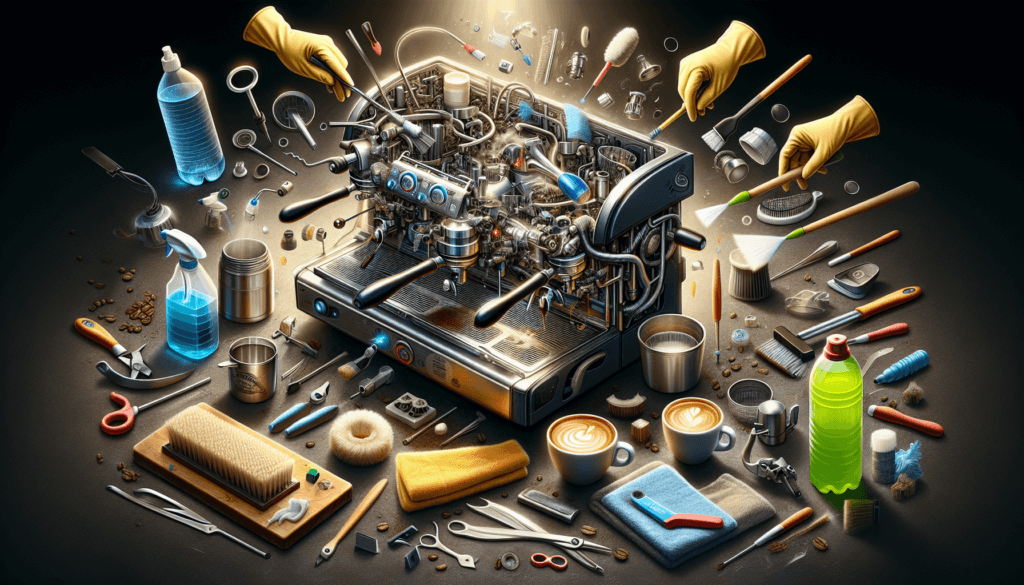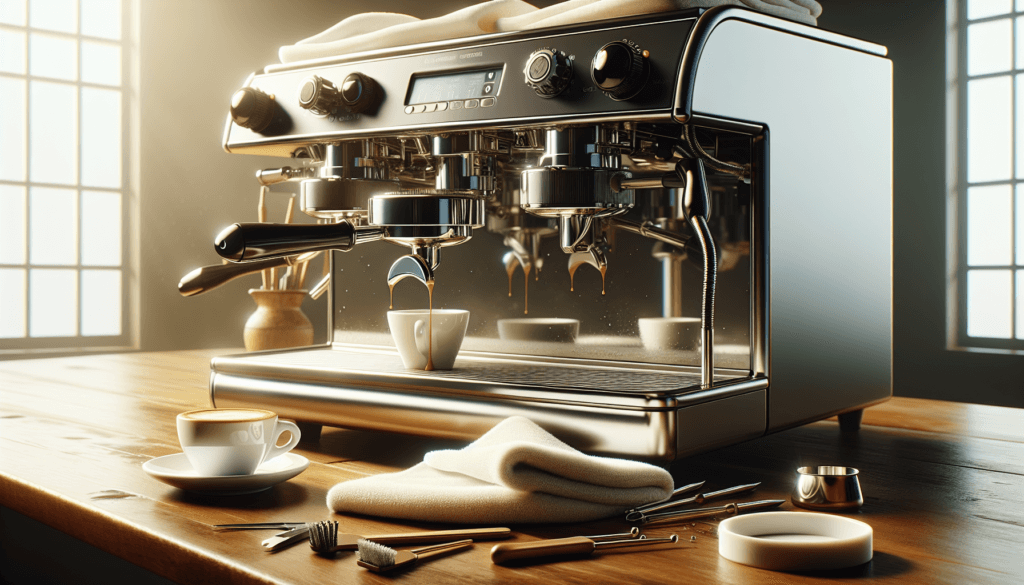Maintaining a clean and well-functioning espresso machine is crucial to brewing the perfect cup of joe. In this article, you will discover the best practices for keeping your espresso machine in tip-top shape. From regular cleaning routines to essential maintenance tasks, we will guide you through the important steps needed to ensure your espresso machine consistently delivers delicious and aromatic coffee. Whether you are a professional barista or a coffee enthusiast at home, these simple yet valuable tips will help you achieve exceptional results every time you make a cup of espresso. So grab your coffee and let’s dive into the world of espresso machine care!
Daily Cleaning Routine

Cleaning the Portafilter and Basket
Cleaning the portafilter and basket should be a part of your daily cleaning routine to ensure that your espresso machine produces high-quality and consistent shots of espresso. Start by removing the used coffee grounds from the portafilter and basket. Rinse them under warm running water to remove any remaining coffee residue. Using a small brush, scrub the basket to remove any leftover oils or particles. Make sure to clean the spouts and grouphead as well to prevent clogs and buildup.
Cleaning the Steam Wand
The steam wand is an essential component of an espresso machine, allowing you to froth milk for your favorite beverages. After each use, it is important to clean the steam wand thoroughly to prevent the buildup of milk residue. Start by wiping the wand with a damp cloth to remove any milk residue. Use a small brush to clean the tip of the wand and ensure that there are no clogs or blockages. This will help maintain the steam wand’s functionality and prevent any potential health risks.
Emptying and Cleaning the Drip Tray
The drip tray collects any excess water and coffee that may accumulate during the brewing process. It is important to empty and clean the drip tray daily to prevent the growth of mold or bacteria. Start by removing the drip tray from the machine and emptying its contents. Rinse it thoroughly with warm soapy water and use a brush to remove any stubborn stains or residue. Make sure to dry it thoroughly before placing it back into the machine.
Wiping Down the Exterior
To keep your espresso machine looking clean and presentable, it is important to regularly wipe down the exterior surfaces. Use a damp cloth or sponge to remove any coffee spills, fingerprints, or dust that may have accumulated. Avoid using harsh chemicals or abrasive materials that could scratch or damage the machine’s finish. By keeping the exterior clean, you not only enhance the aesthetic appeal of your machine, but also prevent any potential contaminants from entering the brewing process.
Weekly Cleaning Routine
Backflushing the Portafilter
Backflushing is a critical step in maintaining the performance and lifespan of your espresso machine. This process involves using a blind filter and espresso machine cleaner to remove any coffee residue and oils that may have accumulated inside the machine. Start by inserting the blind filter into the portafilter and adding a small amount of espresso machine cleaner. Place the portafilter into the grouphead and engage the backflushing process. This will help remove any buildup and maintain optimal performance.
Cleaning the Shower Screen
The shower screen is located in the grouphead and is responsible for evenly distributing water over the coffee grounds. Over time, the shower screen can become clogged with coffee oils and debris, affecting the consistency of the extraction. To clean the shower screen, remove the portafilter and gently remove the shower screen using a screwdriver or similar tool. Soak the shower screen in warm water and espresso machine cleaner to remove any buildup. Rinse thoroughly before reassembling.
Descale the Machine
Espresso machines often require descaling to remove mineral deposits that build up over time. Descaling helps maintain the efficiency of the heating elements and prevents clogs in the water lines. Follow the manufacturer’s instructions for descaling, which may involve using a descaling solution and running it through the machine. Make sure to thoroughly flush the machine with clean water after descaling to remove any remaining residue. Regular descaling will ensure the longevity and optimal performance of your espresso machine.
Cleaning the Grinder
If your espresso machine has an integrated grinder, it is important to clean it regularly to maintain the quality of your coffee. Start by emptying any remaining coffee beans from the hopper. Use a brush to remove any coffee residue from the grinding burrs and the hopper. Wipe down the exterior of the grinder with a damp cloth to remove any coffee dust or oils. Regular maintenance of the grinder will help prevent clogs, ensure a consistent grind size, and ultimately enhance the flavor of your espresso.
Monthly Cleaning Routine
Deep Cleaning the Portafilter and Basket
While the daily cleaning routine helps maintain the portafilter and basket, a monthly deep cleaning is necessary to remove stubborn coffee residue and oils. Start by soaking the portafilter and basket in warm water and espresso machine cleaner for at least 30 minutes. Use a brush to scrub away any remaining residue and rinse thoroughly. This deep cleaning process will help prevent any buildup that could affect the taste and quality of your espresso.
Cleaning the Water Reservoir
The water reservoir holds the water used in the brewing process, and it is important to clean it monthly to prevent the growth of bacteria or mold. Start by emptying the reservoir and discarding any remaining water. Rinse the reservoir with warm soapy water and use a brush to remove any stubborn stains or residue. Rinse thoroughly and refill with fresh water before reattaching it to the machine. Regular cleaning of the water reservoir ensures that your espresso is brewed with clean and fresh water.

Cleaning the Brew Group
The brew group is a crucial component of an espresso machine, responsible for brewing the coffee. Monthly cleaning of the brew group will help maintain its functionality and prevent any clogs. Start by removing the brew group from the machine according to the manufacturer’s instructions. Rinse the brew group with warm water and use a brush to remove any coffee residue or oils. Make sure to dry the brew group thoroughly before reassembling it into the machine. Regular cleaning of the brew group will ensure consistent and flavorful espresso.
Cleaning the Steam Boiler
If your espresso machine has a steam boiler, it is important to clean it on a monthly basis to remove any mineral deposits or scale buildup. Follow the manufacturer’s instructions for cleaning the steam boiler, which may involve using a descaling solution or a citric acid-based cleaner. Thoroughly flush the boiler with clean water after cleaning to remove any remaining residue. Regular maintenance of the steam boiler will prevent clogs and ensure the production of high-quality steam for frothing milk.
Troubleshooting and Maintenance
Identifying Issues with Water Flow
If you notice a decrease in water flow or inconsistent coffee extraction, it may indicate an issue with your espresso machine. Check for any kinks or bends in the water lines that may be obstructing the flow. Ensure that the water reservoir is properly inserted and that there are no blockages in the grouphead or shower screen. If the issue persists, consult the manufacturer’s troubleshooting guide or seek the assistance of a professional technician.
Checking for Build-up or Clogs
Regularly inspecting your espresso machine for any build-up or clogs is essential for optimal performance. Check the portafilter and grouphead for any coffee residue or oils that may have accumulated. Inspect the steam wand for any clogs or blockages. If you notice any build-up or clogs, follow the appropriate cleaning procedures outlined in this article to remove them. By regularly checking for build-up, you can prevent any performance issues and ensure consistent espresso quality.
Replacing Gaskets and Seals
Over time, gaskets and seals can wear down, affecting the functionality and performance of your espresso machine. Inspect the gaskets and seals regularly for any signs of wear or damage. If you notice any leaks or inconsistencies, it may be time to replace the gaskets or seals. Follow the manufacturer’s instructions for replacing these components, or seek the help of a professional technician. Proper maintenance and replacement of gaskets and seals will extend the lifespan of your espresso machine.

Maintenance of the Grinder
If your espresso machine has a grinder, it is important to maintain and service it regularly to ensure optimal performance. Consult the manufacturer’s instructions for recommended maintenance procedures, such as cleaning or replacing the grinding burrs. Regularly check the grind size and consistency to ensure it meets your desired specifications. Proper maintenance of the grinder will result in a consistent and flavorful grind, enhancing the overall quality of your espresso.
Choosing the Right Cleaning Products
Selecting Espresso Machine Cleaner
When choosing an espresso machine cleaner, it is important to select a product specifically formulated for use with espresso machines. Look for a cleaner that is effective in removing coffee oils and residue and is safe to use on various components of the machine. Read reviews and consult with professionals or manufacturers to ensure that the cleaner you choose is of high quality and suitable for your specific machine.
Using Appropriate Descaling Solutions
Descaling solutions are used to remove mineral deposits and scale that can accumulate in espresso machines. It is crucial to choose a descaling solution that is compatible with your specific machine and doesn’t contain any harmful or corrosive chemicals. Follow the manufacturer’s recommendations for descaling and avoid using vinegar, as it can damage certain components of your machine. Using appropriate descaling solutions will prolong the lifespan of your machine and maintain its performance.
Choosing Quality Cleaning Brushes
Cleaning brushes are essential tools for maintaining your espresso machine. It is important to choose brushes that are specifically designed for espresso machine cleaning and are made of high-quality materials. Look for brushes with different bristle sizes to effectively clean various components of the machine. Avoid using abrasive brushes that may scratch or damage the surfaces of your espresso machine. Investing in quality cleaning brushes will ensure thorough and safe cleaning.
Investing in Cleaning Tablets
Cleaning tablets are a convenient and effective way to clean the internal components of your espresso machine. These tablets are designed to dissolve and remove coffee oils and residue, ensuring optimal performance. When choosing cleaning tablets, make sure they are compatible with your machine and follow the manufacturer’s instructions for usage. Regular use of cleaning tablets will prevent clogs, maintain water flow, and enhance the taste and quality of your espresso.
Proper Storage and Care

Removing All Residual Water
Before storing your espresso machine, it is important to completely remove and dry all residual water. Water left inside the machine can lead to mold or bacterial growth, affecting the machine’s performance and risking potential health hazards. Drain the water reservoir and remove any remaining water in the brew group or steam wand. Wipe down all surfaces and components with a dry cloth to ensure they are completely dry.
Covering the Machine
To protect your espresso machine from dust, moisture, and other contaminants, it is advisable to cover it when not in use. Use a clean and breathable cover that fits snugly over the machine. This will prevent dust particles from settling on the surfaces and reduce the risk of any accidental spills or damages. By covering your machine, you ensure that it remains clean and functional for longer periods of time.
Storing in a Dry and Cool Place
Proper storage of your espresso machine is crucial to maintain its longevity and functionality. Store your machine in a dry and cool place to prevent any moisture or temperature fluctuations that may affect its components. Avoid storing it near sources of heat or moisture, such as stovetops or sinks. By storing your machine in an appropriate environment, you reduce the risk of damage and ensure its performance for years to come.
Regularly Checking Components for Wear and Tear
Regularly inspecting the components of your espresso machine for any signs of wear and tear is essential in maintaining its performance. Check the gaskets, seals, buttons, knobs, and other parts for any damage or dysfunction. If you notice any issues, it is important to address them promptly. Follow the manufacturer’s guidelines for replacement or repair, or seek the assistance of a professional technician. By regularly checking for wear and tear, you can prevent any potential malfunctions and extend the lifespan of your machine.
Safety Measures
Unplugging the Machine Before Cleaning
Before starting any cleaning or maintenance procedures, always ensure that your espresso machine is unplugged from the power source. This will prevent any electrical hazards and protect you from accidental shocks or injuries. Handle all components and parts with caution and avoid touching any hot surfaces, especially when the machine has been recently used. By practicing proper safety measures, you can ensure a safe and secure cleaning experience.

Using Protective Gloves and Eyewear
When handling cleaning products or performing maintenance tasks on your espresso machine, it is advisable to wear protective gloves and eyewear. This will prevent any potential skin irritations or injuries caused by contact with chemicals or hot surfaces. Protective gloves and eyewear also provide an extra layer of safety when working with sharp tools or disassembling components. Always prioritize your safety by wearing the appropriate protective gear.
Keeping Children and Pets Away
Espresso machines can pose potential dangers to children and pets, especially when they are in operation or during cleaning and maintenance. Always keep children and pets away from the machine to avoid any accidents or injuries. Store all cleaning products and tools in a secure and inaccessible location to prevent accidental ingestion or misuse. By maintaining a safe distance, you can ensure the well-being of your loved ones and prevent any potential harm.
Following Manufacturer’s Guidelines
One of the essential safety measures when cleaning and maintaining your espresso machine is to strictly follow the manufacturer’s guidelines. Each machine is unique and may have specific instructions or safety precautions that must be adhered to. Familiarize yourself with the user manual and always refer to it when performing any cleaning or maintenance tasks. By following the manufacturer’s guidelines, you can ensure the safe operation and longevity of your espresso machine.
Training and Education for Baristas
Educating Baristas on Daily Cleaning Practices
Proper training and education are crucial for baristas to effectively clean and maintain espresso machines. Baristas should be trained on the daily cleaning practices and routines necessary to uphold the highest standards of cleanliness and hygiene. Providing clear instructions and demonstrations on how to clean the portafilter, steam wand, drip tray, and exterior surfaces will equip baristas with the knowledge and skills to maintain a clean and efficient workspace.
Providing Training on Equipment Disassembly
Espresso machines require periodic disassembly for deep cleaning and maintenance. Baristas should be trained on the proper techniques for disassembling and reassembling various components of the machine, such as the portafilter, shower screen, and brew group. Understanding how to safely and effectively disassemble the machine will enable baristas to address any issues or perform thorough cleanings without causing damage. Regular training on disassembly will help baristas become proficient in maintaining espresso machines.
Teaching Troubleshooting Techniques
Baristas should be equipped with troubleshooting skills to identify and resolve common issues that may arise with espresso machines. Providing training on how to identify issues with water flow, steam pressure, or coffee extraction can help prevent downtime and ensure consistent quality. Baristas should also be trained to recognize the signs of wear and tear or component failure and know when to seek professional assistance. By empowering baristas with troubleshooting techniques, espresso machines can be maintained and repaired more effectively.
Ensuring Proper Technique for Backflushing
Backflushing is a crucial maintenance task for espresso machines, and baristas should be trained on the proper technique. Backflushing requires accuracy and attention to detail to ensure the removal of coffee residue and oils. Improper backflushing may cause damage to the machine or even result in injury. By providing proper training on backflushing technique, baristas can enhance the longevity and performance of espresso machines.
Benefits of Regular Cleaning and Maintenance
Improving Espresso Taste and Quality
Regular cleaning and maintenance of espresso machines directly impact the taste and quality of the espresso produced. Cleaning removes the buildup of coffee residue, oils, and other contaminants that can negatively affect the flavor. Maintenance tasks such as descaling or replacing worn components ensure consistent water flow and correct temperatures. By following a regular cleaning and maintenance routine, baristas can ensure that each shot of espresso is of the highest quality.
Extending Machine Lifespan
Proper cleaning and maintenance significantly extend the lifespan of espresso machines. Regular removal of coffee residue and oils prevents clogs and blockages, reducing the strain placed on various components. Descaling removes mineral deposits that can corrode internal parts and impair functionality. By following a comprehensive cleaning and maintenance routine, espresso machines can operate optimally for many years, providing countless delicious cups of coffee.
Preventing Malfunctions and Costly Repairs
Regular cleaning and maintenance prevent malfunctions and the need for costly repairs. Over time, coffee residue, oils, and scale can build up, clogging or damaging critical components. This can lead to decreased performance, inconsistent coffee extraction, or even complete machine breakdown. By addressing potential issues through regular maintenance, such as replacing gaskets or seals, baristas can avoid costly repairs and prevent interruptions in service.
Ensuring Health and Safety Standards
Keeping espresso machines clean and well-maintained is essential for upholding health and safety standards. The accumulation of coffee residue and oils can lead to bacterial growth, potentially compromising the safety of the espresso produced. Regular cleaning and maintenance prevent the growth of harmful bacteria and mold, protecting both customers and staff. By adhering to proper cleaning practices, baristas can ensure a safe and hygienic environment.
Professional Cleaning Services
Seeking the Help of Espresso Machine Technicians
Professional espresso machine technicians have the expertise and specialized tools necessary to provide thorough deep cleaning and maintenance. If baristas encounter issues beyond their level of expertise or require professional servicing, it is recommended to seek the assistance of technicians. Technicians can diagnose and repair complex issues, ensuring the espresso machine is operating at its best and extending its lifespan.
Scheduling Regular Professional Cleanings
In addition to daily, weekly, and monthly cleaning routines, scheduling regular professional cleanings is highly beneficial. Professional cleanings provide a more comprehensive and thorough cleaning, reaching areas that may be difficult to access with regular maintenance. By entrusting the cleaning to professionals, baristas can focus on providing excellent coffee while knowing that their espresso machines are receiving the care they deserve.
Understanding the Benefits of Professional Maintenance
Professional maintenance services offer numerous benefits that go beyond regular cleanings. Technicians have the knowledge and experience to identify potential issues before they escalate, preventing costly repairs or machine failures. Additionally, professional maintenance services often include specialized treatments, such as descaling or lubrication, that help prolong the lifespan and optimize the performance of espresso machines.
Getting Recommendations for Reputable Service Providers
When seeking professional cleaning or maintenance services for your espresso machine, it is important to choose reputable service providers. Ask for recommendations from trusted sources, such as coffee industry professionals, manufacturers, or other espresso machine owners. Research and read reviews about different service providers to ensure their reliability and expertise. By choosing a reputable service provider, you can have peace of mind knowing that your espresso machine is in capable hands.
In conclusion, cleaning and maintaining an espresso machine is vital for ensuring the production of high-quality espresso and extending the lifespan of the machine. By implementing a comprehensive cleaning routine, troubleshooting and addressing issues promptly, using appropriate cleaning products, and investing in professional services when needed, baristas can provide delicious coffee while maintaining a clean and safe workspace. Regular cleaning and maintenance not only result in better tasting espresso but also contribute to the longevity and efficiency of the espresso machine, ultimately enhancing the overall coffee experience for both baristas and customers.


